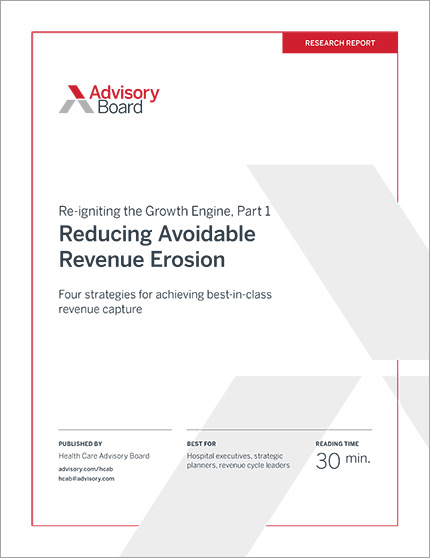Auto logout in seconds.
Continue LogoutRead Advisory Board's take: What to consider when thinking about venture investment
A growing number of nonprofit and academic hospitals are turning to venture capital to test emerging technologies, Toby Abraham reports for Healthcare Dive.
While some big names—such as Cleveland Clinic and Mayo Clinic—have always invested in intellectual property to test new tools and services, other hospitals traditionally have developed new technologies in-house, Abraham reports.
But now, both nonprofit and for-profit hospitals of varying sizes are getting on board with investing in external funds. For hospital fund managers, these risks are similar to other investments but with more flexibility, Abraham reports, noting that hospitals typically opt for a minority stake in a new venture.
And it's often a win for the health care startup. Mary Jo Potter, an investor and consultant in the field, said, "If they (the startup) can get a champion in the organization that really helps refine it, improve it, augment it, that is much more valuable than the money."
Hospitals that are turning to VC
The University of Pittsburgh Medical Center is another health system that's increasingly working with venture capital. The health system's UPMC Enterprises made $243 million when it took its population health management venture, Evolent Health, public in 2015. The health system still retains stock in the venture, according to UPMC Treasurer Tal Heppenstall.
Heppenstall, who's also president of UPMC Enterprises, added that the health system plans to spin out two more companies in the coming months.
Kaiser Permanente's venture arm, Kaiser Permanente Ventures, is also an active investor, Abraham reports. It manages $400 million in assets over four funds, with 28 exits, according to CB Insights.
Mike Phillips—managing director of Intermountain Ventures, Intermountain Health System's VC arm—said the funds present an opportunity to "double dip," as a successful investment can yield both clinical and financial benefits.
Hower, Potter cautioned that most investments don't see an immediate large return. She said it usually takes about a decade to get an exit and that returns are around twice or three times the investment (Abraham, Healthcare Dive, 4/3).
Advisory Board's take

Gillian Michaelson, Consultant, Health Care Advisory Board
As they continue to face declining margins and decelerating revenue growth, it is becoming increasingly critical for hospitals and health systems to explore new approaches for driving different in-kind revenue streams. Venture capital investing, especially in such a way that aligns with broader health system goals, is an ideal avenue for this exploration.
As mentioned above, through this kind of investing, organizations can both potentially reap significant financial rewards, while also promoting products that further their mission to improve health care. Of course investing in brand new product ideas carries significant risks, though hospitals and health systems can use their health care expertise and capabilities to mitigate some of that risk through careful product selection. Furthermore, provider institutions can help facilitate the success of their chosen ventures by providing start-ups with a valuable place to test their ideas in the setting where they'll ultimately need to be most applicable.
“This unique hospital and health system value proposition turns organizations into coveted investors”
This unique hospital and health system value proposition turns organizations into coveted investors and makes it possible for institutions of all sizes to actively enter this space even at lower dollar amounts than are typically required of venture capital firms.
That said, just being a provider is insufficient to create a fully-formed venture value proposition. Organizations must establish processes to hard wire innovation into business practices and to recruit internal champions to work with start-up leaders. This could mean developing large business development and innovation center functions. It could also mean assembling a relatively small team responsible for coordinating with different leaders across the hospital or system. This decision will depend on how large and dispersed the hospital or health system is and what level of resource commitment they are prepared to make.
“Look for a company that wants a strategic partner, not just another investor”
Whichever approach hospitals and health systems take to formalizing their internal operations, the most important characteristic they should be looking for externally is a company that wants a strategic partner, not just another investor. In this way, the hospital or health system’s resources will be best used. Additionally, this produces the greatest likelihood that the product will later also be applicable for promoting other health system strategic ends.
Ultimately, venture investing is one of many approaches your organization could potentially take to drive new revenue streams within today’s tight margins. To learn more about different approaches, the risks and potential rewards involved, and to identify the right starting place for you, download part three of our series on Re-igniting the Growth Engine.
Webconference series: How to secure future growth in a rapidly restructuring market
At our 2018–19 Health Care Advisory Board national meeting series, we covered strategies to help health care leaders navigate a rapidly restructuring and consolidating marketplace, while developing a comprehensive revenue growth playbook to promote sustainable future margins. If you weren’t able to join us, need a refresher on the content, or want to share the research with your team, this webinar series recaps the key insights and top case studies from the series.
Don't miss out on the latest Advisory Board insights
Create your free account to access 1 resource, including the latest research and webinars.
Want access without creating an account?
You have 1 free members-only resource remaining this month.
1 free members-only resources remaining
1 free members-only resources remaining
You've reached your limit of free insights
Become a member to access all of Advisory Board's resources, events, and experts
Never miss out on the latest innovative health care content tailored to you.
Benefits include:
You've reached your limit of free insights
Become a member to access all of Advisory Board's resources, events, and experts
Never miss out on the latest innovative health care content tailored to you.
Benefits include:
This content is available through your Curated Research partnership with Advisory Board. Click on ‘view this resource’ to read the full piece
Email ask@advisory.com to learn more
Click on ‘Become a Member’ to learn about the benefits of a Full-Access partnership with Advisory Board
Never miss out on the latest innovative health care content tailored to you.
Benefits Include:
This is for members only. Learn more.
Click on ‘Become a Member’ to learn about the benefits of a Full-Access partnership with Advisory Board
Never miss out on the latest innovative health care content tailored to you.

